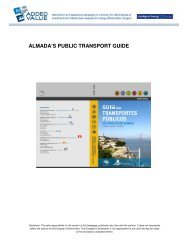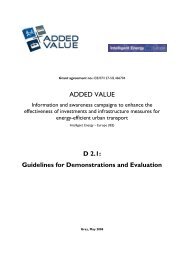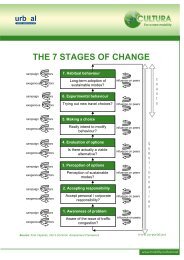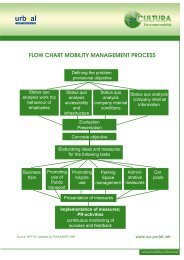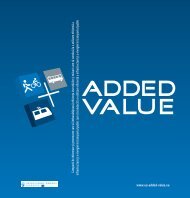SUMO - Eltis
SUMO - Eltis
SUMO - Eltis
Create successful ePaper yourself
Turn your PDF publications into a flip-book with our unique Google optimized e-Paper software.
COMBINATION OF PHYSICAL MEASURES AND MOBILITY MANAGEMENT<br />
This example describes how <strong>SUMO</strong> can be used when a physical measure is combined with mobility<br />
management.<br />
Comment 1:<br />
MOST-MET was created for evaluating mobility management measures. We have extended this in<br />
<strong>SUMO</strong> to include other behaviour-changing measures, such as in the field of road safety, and have<br />
therefore used the term mobility projects.<br />
With some thought, <strong>SUMO</strong> can also be applied to projects that combine physical measures and<br />
mobility management. This is interesting as a combination of physical measures and mobility<br />
management can result in significant synergy effects.<br />
This example describes suggestions for indicators to measure how the combination of a physical<br />
measure “cycle path” and mobility management has worked. There are of course other effects of the<br />
cycle path that are not illustrated in this example, and it is not possible to get a comprehensive grasp<br />
of the factors behind the use of the cycle path by all cyclists. However, it is useful for evaluating the<br />
effect of mobility management measures in combination with a physical measure.<br />
As in many other cases, one can evaluate both at an overall macro level, which sees all mobility<br />
management measures as a whole (sometimes the only possible), or to evaluate each measure<br />
individually. It is often difficult to know which of the measures has led to a result.<br />
Problem description<br />
Several companies in an industrial park are planning to expand and create new jobs. Most of the<br />
existing workforce and the new employees live in a town close by. The industrial park is 4 km 8 from<br />
the town centre and along the “main road” that links the town with the main national road network,<br />
which runs about 10 km outside the town.<br />
The business expansion, together with the general rise in traffic volume, is expected to lead to a rise<br />
in passenger car traffic between the town and the industrial park, even if attractive alternatives to<br />
single occupancy car travel are offered. Many claim that the existing road must be rebuilt with wider<br />
hard-shoulders and possible new lanes to meet the future rise in traffic.<br />
There is currently no cycle path and cyclists and pedestrians share the same road space as motor traffic.<br />
The rise in car traffic is expected to result in shortcomings in road safety for cyclists and pedestrians<br />
and lead to further limitations for people that currently cycle or walk. Public transport is widely<br />
used but there is sufficient capacity to meet the expected increase in passengers that the planned new<br />
jobs is expected to generate. Cycle and public transport are therefore expected to complement each<br />
other in the future.<br />
Local political leaders have very strong financial and environmental reasons to develop conditions for<br />
local industry and to create a community with a well-constructed environment, which should be<br />
attractive for a new workforce.<br />
The businesses are interested in developing their environmental profiles and in external environmental<br />
issues. They also have strong economic incentives to become involved in their employees’ choice of<br />
8Surveys have shown that cycling is an attractive alternative to cars for short journeys up to 5 km and that cycles are mainly used for<br />
journeys to school and work, and for recreation.<br />
sumo – Appendix 45<br />
4<br />
EXAMPLE



